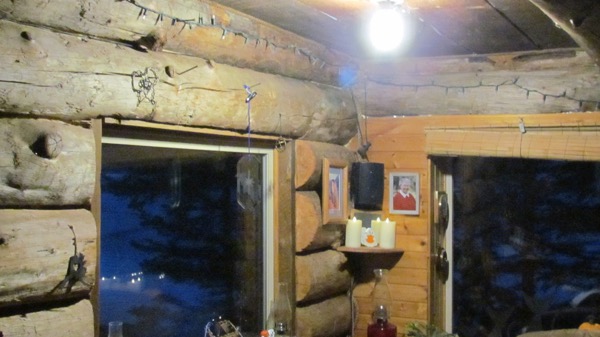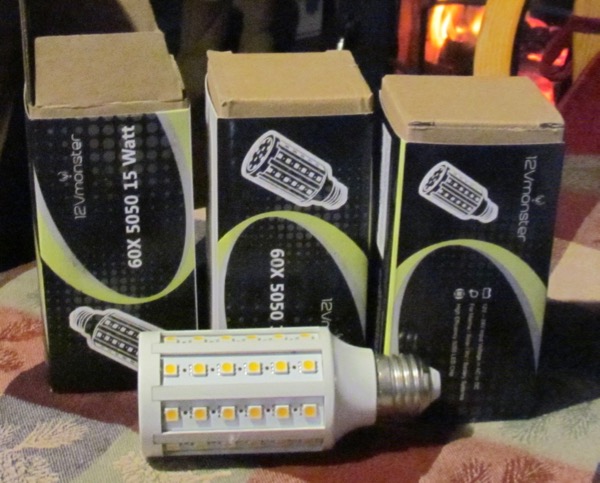We had a unique occurrence in the cabin recently: an LED cluster light bulb burned out.
I remember writing about these clusters on the blog at one time. I found out I’d done that in March 2013 (see Light Housekeeping). In one of the last posts (Light Housekeeping Concluded) I profiled the LED cluster bulbs, commonly called “corn cobs” because of their appearance, and noted that only time would tell if they were effective. Time did tell; they were effective, this particular one for five and a half years. That’s not bad for a “single” light bulb.

Hard to tell in a snapshot, but the new LED cluster bulb bathes our living area in warm light (Photo: Mark A. Zeiger).
We decided to purchase more of these bulbs, and made a pleasant discovery: technology continues to improve (whoulda thunk it?). We found that the current version of the 60X 5050 15 Watt cluster, (paid link) (ask your local, independently-owned hardware store) which we bought more than five years ago at $18.99, is now a couple of dollars cheaper. They also accept wide range input, specifically able to handle the higher voltage level of our nickel-iron battery.
Perhaps best of all, they’re now available in warm white light. Our living room now appears to be bathed in candle light. Much more relaxing and cozy!
Our original 60X 5050 still burns. It’s a “colder” white light, which works well in a kitchen. My current plan involves using it in a new “Edison” socket over the kitchen sinks, replacing the Thinline fluorescent fixture I’d installed there years ago. It has burned out at a unit, possibly because of the higher voltage of the Ni-Fe batteries.
Amazingly, I’m inspired to finally get around to building the globe holders for these lights, mentioned in 2013, but never a priority. Now, it appears I might actually finish our fixtures.
These new bulbs, because they can handle the high voltage, may last even longer than the bulb that failed. Again, time will tell, and someday, I may post a further update on LED lighting in our cabin.
Note: the post above contains affiliate ads.


As an electrical engineer I get quite interested in *how* an LED lamp (‘bulb’) failed and often do a post-mortem on them. I appreciate that most people don’t care.
Can you describe how the lamp failed? Did all the LEDS stop working at once (suggesting a failure in the power supply circuit), did you lose one or more ‘strings’ of LEDs around the lamp or did the LEDs fail, one initially and then more and more until most/all had failed?
Six years is well below average for the lifetime of a good LED (even if you ran it 24/7) so it was probably a failure of a component in the power supply.
I don’t know a lot about NiFi but from a quick read it appears that a 12V battery would required charged at about 16V. I can see this would be a little high for a lot of 12V consumer electronics. Have you considered a DC-DC converter to drop the ~16V down to 12V to keep your electronics happy?
Ekij, I’d be very interested to know more about this, too. I couldn’t find any documentation, but the (less than) 6 year life seems a bit low. I chalked it up to the higher NiFe voltage, but I’m not sure.
The bulb failed all at once, no strings or individual LEDs went out. It took a while; it would “turn off,” we’d turn the switch off, wait a moment or two, then turn it on again. At first, it would continue lighting until we turned it off. We might have gotten more life out of it with a little messing around, but we didn’t want to nurse it along, and replaced it.
Because the whole cluster failed at once, I at first assumed we had a fault in the wiring, and tried to trace that. I couldn’t find any problems with the switch or wiring, and one of the new lamps has worked without trouble ever since.
I had not considered a DC-DC converter, as I didn’t know such a thing existed. The new bulbs seem to take care of that, but there are a few other DC items around the house that have limited use with the higher voltage. I will look into it, and do a cost analysis.
Am I right in remembering you’re in the U.K.? I’d be tempted to send you this bulb if you wanted to do an autopsy on it.
Mark,
Yes I’m in the UK (Northern Ireland). I expect shipping would be prohibitive.
AS far as a DC to DC converter is concerned something like this:
https://www.amazon.com/DROK-Converter-5-3V-32V-Regulator-Transformer/dp/B078Q1624B/ref=sr_1_8?keywords=DC+to+DC+converter&qid=1573210524&sr=8-8
might be of interest.
If so; I will happily send you an Amazon gift to cover the cost as a thank you for years of reading your blog.
We can discuss further off the open forum if you want.
(For once I’ve actually entered my real email address)
Thank you for your generous offer, Ekij! I’ve emailed you from our Gmail account (in your SPAM folder now, no doubt!).